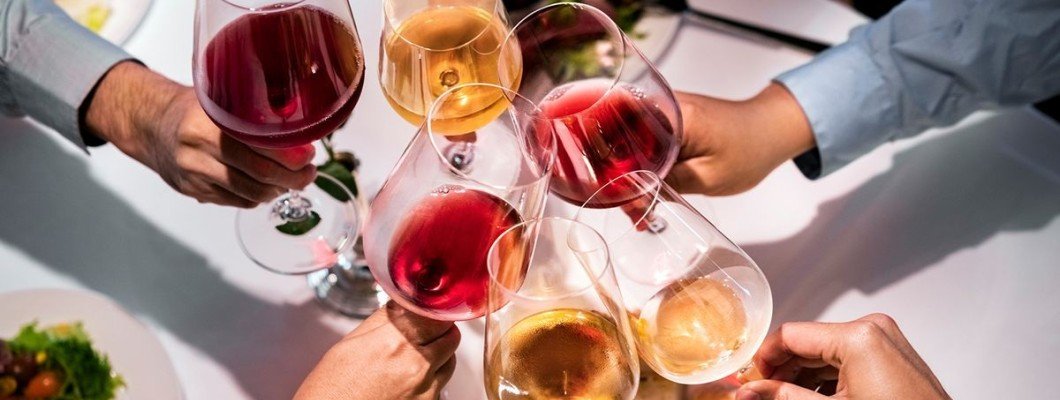
Wine glasses are a must for any wine tasting. They magnify the wine, bring out its aromas and come in all shapes and sizes. In this article we present this indispensable element in the world of wine.
The Short History of the Wine Glass
Wine glasses as we know them today did not appear until the beginning of the 14th century. At that time they were a reflection of the Venetian know-how of the island of Murano, which exported them throughout Europe. Thereafter, in France in the 18th century, several wines were sometimes tasted at the same time with a meal. This is why glass service became popular in the 19th century. Each cup has its own purpose. In addition, glass at this time is becoming more and more democratic, and it is no longer the monopoly of the bourgeoisie, but is used more and more frequently.
In the 20th century, Claus Riedel was the first to link the shape of a wine glass to its effect on taste. He then revolutionized the wine glass style, developing the mouth-blown, colorless, very thin wine glass. He then launched the "Sommeliers" collection, the first collection of wine glasses designed according to the style and character of each wine. In other words, this marks a turning point for Blackjack. Even today, Riedel is one of the world's leading glass brands.
In the 1970s, the INAO wine glass became the reference glass for professional wine tastings. It is defined by a set of specifications from the French Association for Normalization (AFNOR) and receives its certification in 1971.

The structure of the wine glass
Three main elements form the wine glass: the stem, the foot and the bowl. Other elements, less known to the general public, have their importance. This is what we will see below.
Let’s start with the main elements:
- The stem, also known as the base, allows the glass to be balanced.
- The foot connects the stem to the glass container. It is this element that allows you to hold your glass during tasting.
- The bowl (also called chalice), represents the container and allows the drink to be poured inside.
Let’s move on to the next ones:
- The gob is the lower part of the bowl, which acts on the oxygenation of the wine. It can take different shapes (round, straight, etc.).
- The shoulder is the widest part of the bowl. It allows the development of the wine’s aromas.
- The chimney, the upper part of the bowl and narrower than the rest, prevents the aromas from escaping.
- Finally the rim of the bowl, where you put your lips, has an impact on the taste of the wine when tasting it.
It is all these elements, assembled together, that give the distinctive and recognizable shape of wine glasses.
Choosing your wine glass
During the tasting, 3 of our senses are activated: sight, smell and taste. And the wine glass plays a decisive role for each one. Some characteristics are particularly important to consider when choosing a glass.
Choosing a glass
The transparency influences the visual analysis. Indeed, it is important to see the colour, the robe of the wine to fully appreciate the tasting.
The size and shape of the glass which influence the gustatory and olfactory analysis. For example, with the diameter of the container larger than that of the opening, the aromas (volatile molecules) of the wine spread and reach the taster’s nose. Be careful however not to have an opening that is too closed because the aromas will not be perceived.
Be careful when choosing the glass because its thickness also plays a role in the tasting. For an optimal olfactory analysis, the rim must be as thin as possible. The finer it is, the more the taste will run through your mouth.
There is a “universal” form: the INAO wine glasses we mentioned. They are characterized by a wide bowl and a narrowed opening. If you have small spaces, you can opt for INAO glasses that will suit all your tastings.
A few basic rules to follow when choosing and preserving your wine glasses
Of course you want to get the best of your wine tastings, so here are a few tips to succeed.
- Do not taste your wines in straight water glasses. Indeed, it is important to hold your glass by the foot, first to avoid unwanted fingerprints and most importantly, to avoid heating the wine when holding the glass by the bowl.
- Do not take tinted glasses, because seeing the colour of your wine is part of the visual analysis of a tasting.
- Wash the glasses only with warm water, without any detergent or soap. The dishwasher should also be avoided.
- Wipe the glasses immediately after washing them to avoid leaving traces of limescale.
- In terms of glass size, there is no need to use XXL size glasses, which are harmful for the aromas of the wine during tasting.

Leave a Comment